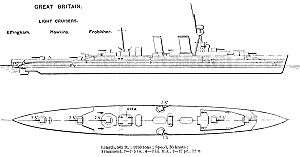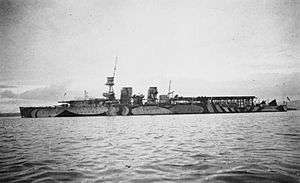Hawkins-class cruiser
 | |
| Class overview | |
|---|---|
| Name: | Hawkins class |
| Operators: |
|
| Preceded by: | None |
| Succeeded by: | County class |
| Built: | 1916 - 1925 |
| In commission: | 1919 - 1949 |
| Completed: | 5 |
| Lost: | 2 |
| Scrapped: | 3 |
| General characteristics | |
| Type: | Heavy cruiser |
| Displacement: |
|
| Length: | |
| Beam: | 58 ft (18 m) (65 ft across bulges)[1] |
| Draught: | 17.25 ft (5.26 m)[1] (20.5 ft (6.2 m) full load) |
| Propulsion: |
|
| Speed: | 31 knots (57.4 km/h) (30 knots (55.6 km/h) Hawkins) |
| Range: | 5,400 nmi (10,000 km) at 14 knots (26 km/h)[1] |
| Complement: | 712 / 750 flag |
| Armament: |
|
| Armour: |
|
| Aircraft carried: | See Vindictive |
The Hawkins class was a class of five heavy cruisers of the Royal Navy designed in 1915 and constructed throughout the First World War. All ships were named after Elizabethan sea captains. The three ships remaining as cruisers in 1939 served in the Second World War, with Effingham being an early war loss through wreck; this was unusual since Raleigh was lost in a similar shipwreck on uncharted rocks in 1922 (and Vindictive was nearly lost to grounding in 1919). Vindictive, though no longer a cruiser, also served throughout the War. This class formed the basis for the definition of the maximum cruiser type under the Washington Naval Treaty of 1922.
Design

Although the Hawkins class were the first heavy cruisers built for the Royal Navy, they were designed as improved versions of the Birmingham sub-class of the Town-class light cruisers, thus they were initially known as the "Improved Birmingham" type. Their lineage descended through an intermediate sketch design of 1912 known as the "Atlantic Cruiser", armed with a combination of 7.5 and 6-inch (190 and 152 mm) guns, designed to counter reported large German cruisers armed with 7-inch (170 mm) guns.
In 1915, a new design of cruiser was prepared for trade protection on distant waters, for which a heavy armament, long range and high speed was required; meaning a large ship. Previous large cruisers had been of the armoured cruiser or protected cruiser type. These ships had been made obsolete by the adoption of oil-firing and the steam turbine engine and had been superseded by the battlecruiser and the light cruiser. The Hawkins design was basically a light cruiser enlarged sufficiently to increase their range and armament as required. A mixed armament of 9.2 and 6-inch guns was rejected after wartime experience illustrated the difficulty of controlling a mixed battery as shell splashes could not be differentiated. Thus, a uniform battery of 7.5-inch calibre was adopted, controlled by the innovation of director firing.
The development of director firing made the planned armament obsolete, as director control relies on "straddles" in which some shells in a given salvo are seen to fall short of the target and some long. As long as straddles are maintained, some percentage of the shots will be hits. With a main battery consisting of only two guns, a straddle of one shell falling short and one long mathematically eliminates the possibility of a hit, while a uniform six-gun broadside allows the possibility of up to four hits out of a straddle.
The boilers were initially a combination of coal and oil firing to ensure a supply of fuel on distant stations; coal being more available and the ships could cruise on coal firing alone. The installed power was 60,000 shp (45,000 kW) for 30 knots (56 km/h). However, only Hawkins and Vindictive were completed as such. The other ships were not constructed with as much haste and were completed post-war with oil-firing only, increasing power to 70,000 shp (52,000 kW) for 31 knots (57 km/h).
These ships did not suit the Royal Navy's post-World War I needs well, as Britain needed numbers of cruisers, rather than individually powerful ships. As breaking them up on the slips would have been an unwarranted waste of money, they were completed anyway. At just under 10,000 tons and armed with 7.5-inch guns, they became the prototype of the heavy cruiser designs based on limitations set by the Washington Naval Treaty in 1922.
Vindictive

The fifth and last ship of the class - laid down as Cavendish - was altered to an aircraft carrier while building, renamed Vindictive to perpetuate the name of the cruiser sunk at the Second Ostend Raid and her construction was rushed to bring her into service before her cruiser sisters. She had a 100-foot (30 m) flying-off platform forwards and a 215-foot (66 m) landing deck aft and a hangar for up to eight aircraft. She was armed with four 7.5 inch and six 12-pounder guns. In 1923 she reverted to a cruiser, but retained the hangar forwards and did not carry a 'B' gun; a crane and catapult being carried instead for seaplanes. After 1935 she did not serve in a cruiser role.
Modifications
_in_1938.jpg)
No ships were completed with the original design secondary armament. Hawkins carried only the 12-pounder anti-aircraft (A/A) guns, her sisters having two (Raleigh) or three (Frobisher, Effingham) QF 4-inch Mark V guns on mountings HA Mark III. In 1929, Hawkins had her 12-pounder guns replaced by an equal number of the same model of 4-inch (102 mm) guns as her sisters. Frobisher was partially disarmed as a training ship in 1932, but reverted to a cruiser in 1937 when Vindictive was specially demilitarised for this role.
The ships were scheduled for disposal in 1936, but rising international tensions caused their retention. In 1937, Effingham was rebuilt as a light cruiser with nine BL 6-inch Mark XII guns on single mountings CP Mark XIV. These were shipped superfiring forwards in 'A', 'B' and 'C' positions, on either wing, triple aft in 'W', 'X' and 'Y' positions with the ninth gun being on the quarterdeck in position 'Z'. The after boiler rooms were removed and the remaining uptakes trunked into a single large funnel. Secondary armament was eight QF 4-inch Mark XVI on twin mountings HA/LA Mark XIX, eight QF 2-pounder Mark VIII guns on two quadruple mountings Mark VII and twelve 0.5 inch Vickers machine guns on three quadruple mountings Mark I. The submerged torpedo tubes were removed. She had a new bridge and spotting top and carried a crane amidships; the catapult and aircraft were never fitted.
It had been planned to rebuild Hawkins and Frobisher on similar lines, but other priorities prevented this. They were re-armed for war with all their 7.5-inch (191 mm) guns, except in Frobisher which had the wing guns removed so that the 4-inch (102 mm) gun deck could be extended out to the ship's sides. In 1940, they received two (Hawkins) or four (Frobisher) quadruple 2 pounder "multiple pom-pom" mountings and seven (Frobisher) or eight (Hawkins) 20 mm Oerlikon guns on single mountings P Mark III. They received an outfit of centimetric Radar Type 273 target indication on the bridge, Type 286 air warning at the mastheads, Type 275 on the HACS 4-inch (102 mm) gun director for ranging and bearing and, in Frobisher only, a pair of Type 282 sets on the pom-pom directors on the bridge. Further wartime additions increased the number of 20 mm guns.
Service

- Raleigh had the shortest career of any ship of the class, spending just one year in commission before being wrecked and subsequently broken up.
- Effingham was an early war loss, during the Norwegian campaign, grounding on an uncharted shoal, she had to be destroyed by friendly forces.
- Hawkins served in World War II as a convoy escort in the Indian Ocean, also provided gunfire support during the Normandy landings.
- Frobisher served in World War II as a convoy escort and a depot ship for the Normandy landings. They were relegated to training roles by 1945, with a corresponding reduction in armament.
- Vindictive served in two World Wars, in a wide variety of roles, finally being scrapped in 1946.
Ships
Four ships were ordered in December 1915:
- named after John Hawkins,
- built by HM Dockyard Chatham,
- laid down 3 June 1916,
- launched 1 October 1917,
- completed 19 July 1919.
- Sold for breaking up 26 August 1947.

- named after Walter Raleigh,
- built by William Beardmore & Company, Dalmuir,
- laid down 4 October 1916,
- launched 28 August 1919,
- completed July 1921.
- Wrecked Point Amour, Forteau Bay, Labrador 8 August 1922, stripped and wreck demolished September 1926.
- named after Martin Frobisher,
- Built by HM Dockyard Devonport,
- Laid down 2 August 1916,
- Launched 20 March 1920,
- Completed 3 October 1924.
- Sold for breaking up 26 March 1949.
- named after Charles Howard, Lord Effingham,
- Built by HM Dockyard Portsmouth,
- Laid down 2 April 1917,
- Launched 8 June 1921,
- Completed 9 July 1925. Rebuilt as light cruiser 1937,
- Wrecked Faksen Shoal, Bodø, Norway 18 May 1940, destroyed by gunfire & torpedoes by HMS Matabele 21 May 1940.
A fifth ship was ordered in April 1916, but was completed as an aircraft carrier:
- named after Thomas Cavendish,
- built by Harland & Wolff, Belfast,
- laid down on 29 May 1916, redesigned as an aircraft carrier,
- launched on 17 January 1918, renamed Vindictive on 29 June 1918
- completed October 1918.
- Converted back to a cruiser 1923–1925, training ship 1937, repair ship 1940, destroyer depot ship 1944. Sold for breaking up February 1946.
See also
Notes
References
- Brown, D. K. The Grand Fleet, Warship Design and Development 1906-1922. Chatham Publishing. ISBN 1-86176-099-X.
- Whitley, M. J. Cruisers of World War Two; An International Encyclopedia. Caxton Editions. ISBN 1-86019-874-0.
- Gardiner, Robert (ed.). Conway's All the World's Fighting Ships, 1922-1946. Naval Institute Press. ISBN 0-87021-913-8.
- Lenton, H. T. British and Empire Warships of the Second World War. Greenhill Books. ISBN 1-85367-277-7.
External links
| Wikimedia Commons has media related to Hawkins class cruiser. |